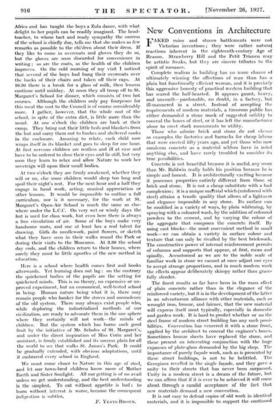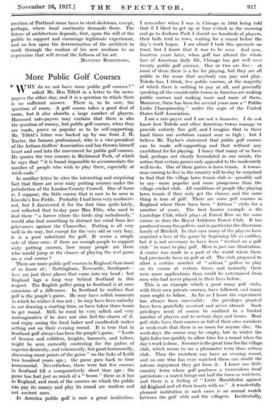New. Conventions in Architecture F AKED ruins and stucco battlements were
not Victorian inventions ; they were rather natural reactions inherent in the eighteenth-century Age of Reason. Strawberry Hill and the Petit Trianon may be artistic freaks, but they are sincere tributes to the spirit of romance.
Complete realism in building has no more chance of ultimately winning the affections of man than has a plain but functionally efficient woman, and it is precisely this aggressive honesty of practical modern building that has scared the half-hearted. It appears gaunt, heavy, and uncouth—pardonable, no doubt, in a factory, but ill-mannered in a street. Instead of accepting the requirements of modern materials, a timorous public has either demanded a stone mask of suggested solidity, to conceal the bones of steel, or it has left the manufacturer alone to erect stark monuments to utility.
Those who admire brick and stone do not clic ose as examples, the factories and barracks for cheap labour. that were erected fifty years ago, and yet those who now condemn concrete as a material seldom have in mind anything else, and have rarely troubled, to consider its true possibilities.
Coperete,is not beautiful because it is useful, any mom than Mr. Baldwin really holds his position because he is simple and honest. It is architecturally exciting because it possesses properties entirely different from those of brick and stone. It is not a cheap substitute with a bad complexion ; it is a unique material which (reinforced with steel) attains a tensile quality that allows of a lightness and elegance impossible in any stone. Its surface can be modified in a variety of ways, by plain whitening, by spraying with a coloured wash, by the addition of coloured powders to the cement, and by varying the colour of the aggregate that composes the concrete, itself. By using cast blocks—the most convenient method in small work—we can obtain a variety in surface colour and texture that can only be rivalled by the best brickwork.
The constructive power of internal reinforcement permits of columns and supports that appear, at first, mean and spindly. Accustomed as we are to the noble scale of familiar work in stone we cannot at once adjust our eyes to accept strange proportions, and in much modern work the effects appear deliberately skimpy rather than grace- fully slender.
The finest results so far have been in the mass effect of plain concrete rather than in the elegance of the reinforced variety, but it is in the development of the latter in an adventurous alliance with other materials, such as wrought iron, bronze, and faience, that the new material will express itself most typically, especially in domestic and garden work. It is hard to predict whether or no the steel frame of modern street building has any such possi- bilities. Convention has veneered it with a stone front, applied by the architect to conceal the engineer's bones. Sometimes bronze sheets have replaced the stone, and these present an interesting conjunction with the huge expanses of plate-glass demanded by the big shop. The importance of purely fagade work, such as is presented by. these street buildings, is not to be belittled. . The Georgians revelled in the single facade, and they gave a unity to their streets that has never been surpassed. Unity in a modern street is a dream of the future, but we can affirm that if it is ever to be achieved it will come about through a candid acceptance of the fact that new materials demand a new convention.
It is .not easy to defend copies of old work in identical materials, and it is impossible to support the continued erection of Portland stone faces to steel skeletons, except, perhaps, where local continuity demands them. The future of architecture depends, first,' upon the will of the public to support and encourage legitimate experiment, and no less upon the determination of the architect to work through the realism of his new medium to an expression that will reveal the fullness of his art.
MANNING ROBERTSON.























































 Previous page
Previous page